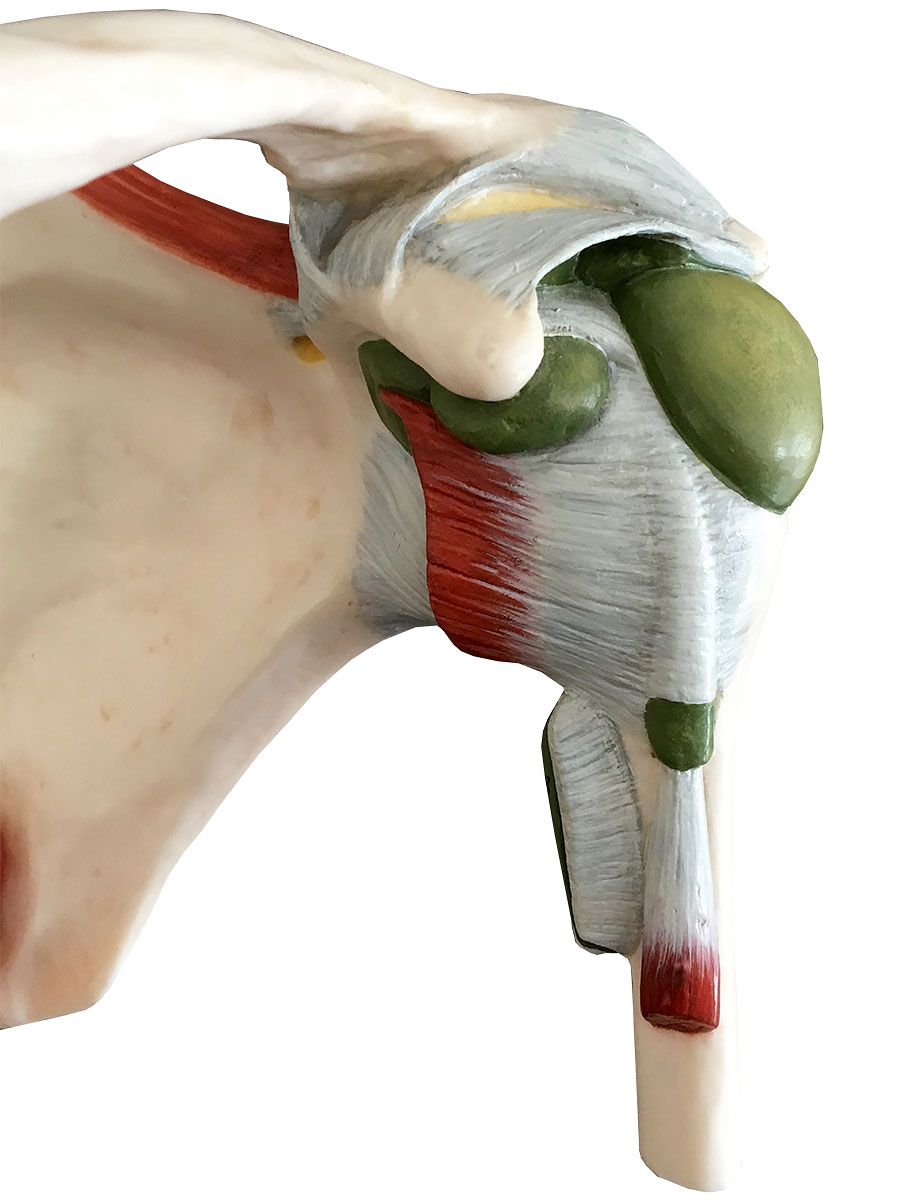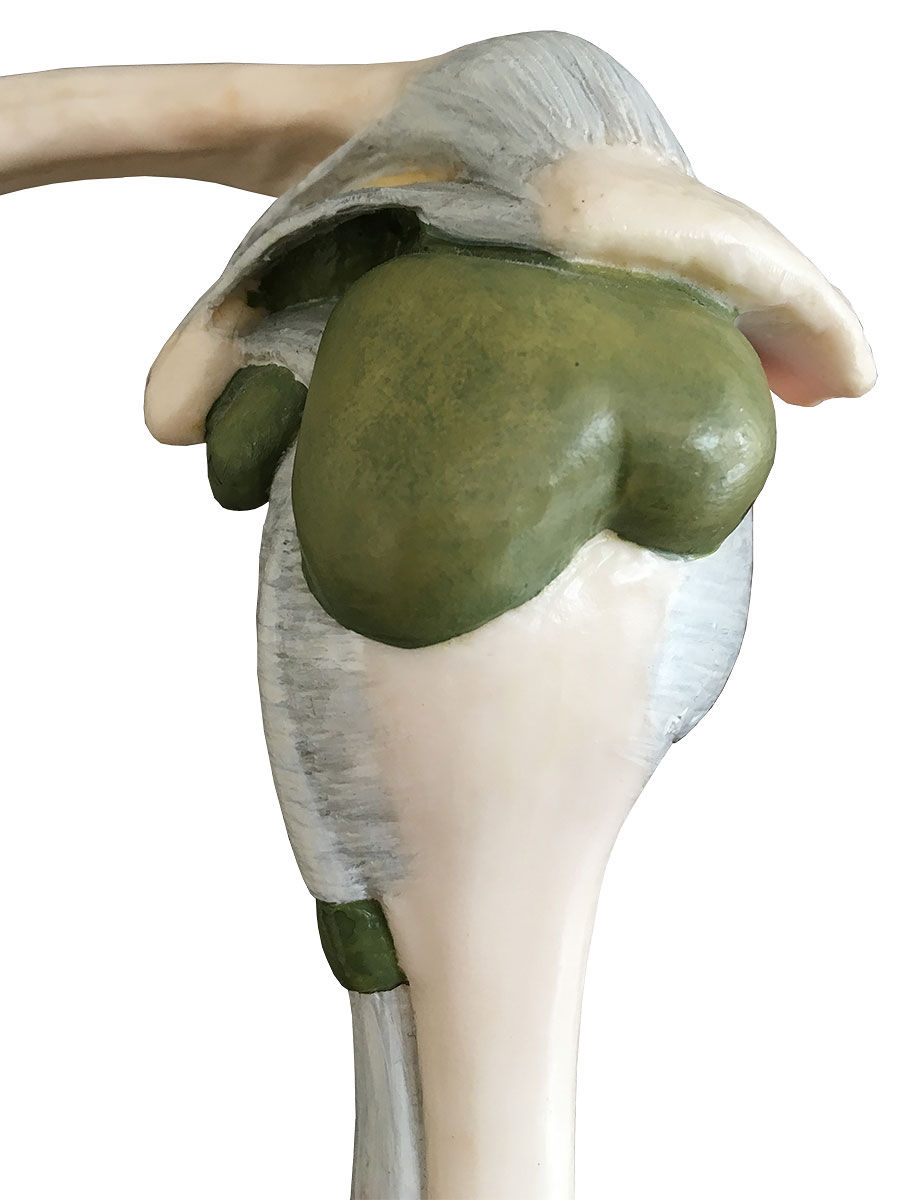A Normal Shoulder Joint
The main shoulder joint is a ball and socket type joint, with a large ball held against a smaller socket (much like a golf ball on a tee.) This discrepancy in size allows the ball a wide freedom of movement. To stabilise the ball in the socket a group of 4 short strong muscles powerfully pull the ball into the joint. These muscles and the tendons attaching them to bone are call the rotator cuff.
The repetitive use of the shoulder and its intricate anatomy makes it prone to “wear and tear” type injuries. Other problems may occur from single episodes of more severe trauma.


About Rotator Cuff Pathology
Many patients present with a painful shoulder condition: which arises from irritation or tearing of the strong tendons around the humeral head (ball of shoulder joint).
In the majority of cases an attempt at non-operative management will be made, as the pain will often settle with time. Some patients will require surgery to relieve pain and perhaps improve strength.
Rotator Cuff Impingement and Tears
The tendons normally glide smoothly between the humeral head (ball) and the acromion (shoulder tip). A fluid-filled sac (called a bursa) helps lubricate this movement and provide smooth gliding of the tendons. Following injury, overuse or long-term “overhead activities” a bony spur can develop under the acromion and press against the bursa and tendons (impingement). Some people have a slightly abnormal shape to the acromion that may also press against the bursa. The pressure of a spur or “hooked acromion” may cause pain with shoulder activity and, with time, can irritate the tendons sufficiently to cause a tear in the tendon and subsequent weakness. While irritated the tendons generally swell (inflammation) and effectively reduce the amount of free space between the two bones.
Impingement and tears are most common in patients over 40 years of age although can occur in younger people after trauma. Many patients over 50 – 60 years of age will not require surgery, even if there is a tear in the tendon.
The pain of rotator cuff impingement or tear is most commonly felt when elevating the arm and squeezing the bursa and tendon between the acromion and humeral head.
Forward elevation of the arm when performing tasks such as driving, lifting objects onto shelves, hanging out the washing etc. may produce this effect.
Investigations for Rotator Cuff Pathology
To confirm the presence of a bony spur and to ensure no other major shoulder problems are present; most patients will have simple X-rays performed.
An ultrasound is often obtained to see if the tendons are swollen or have a tear in them. Tendons may have complete or partial (only on undersurface or top surface) tears in them. Ultrasound scans are very reliable at identifying complete tears although are not as reliable at differentiating a partial tear.
Many patients are referred with an ultrasound confirmation of a tendon tear and a belief that they will require surgery for the tear. Most tears however will not require surgery despite not healing spontaneously. If all persons over ~ 60 years old have ultrasound assessment of their shoulders a large number of otherwise symptom-free rotator cuff tears will be identified. This suggests that a tear alone is not an indication to jump straight into an operation.
Treatment Options for Rotator Cuff Pathology
Before considering surgery for either impingement or tears most patients will be advised to trial other treatments. Significant pain relief and functional improvement may occur with anti-inflammatory medications, painkillers, physiotherapy and modifying activity levels. An injection of cortisone / steroid into the area may reduce swelling enough to provide long-term pain relief.
Non-operative treatment
Studies show that more than 50% of patients have decreased pain and improved motion and are satisfied with the outcome of non-surgical treatment. Surgeons may recommend nonsurgical treatment for patients who are most bothered by pain, rather than weakness, because strength does not tend to improve without surgery.
There are a few predictors of poor outcome from nonsurgical treatment:
- Long duration of symptoms (more than 6 to 12 months)
- Large tears (more than 3 centimeters)
- Large spurs or severe hook deformity of the acromion
Nonsurgical treatment has both advantages and disadvantages.
- Advantages include: avoidance of surgery and its inherent risk. Less "down time”.
- Disadvantages include: Strength may not improve. Tears may increase in size over time. Patients may need to decrease their activity level. Over a long period, arthritis may develop.
Corticosteroid injections (“Cortisone”)
Cortisone is a powerful anti-inflammatory medication that can reduce local inflammation. Because the medication is injected directly into the area of inflammation the effects of the medication are concentrated on the site to decrease the swelling and pain. The injection is safe and fast. It involves little or no pain and therapeutic injections have important benefits. They deliver the medicine to the exact spot that needs it. They also allow you to use lower and fewer doses of oral steroids, which are highly toxic.
There is some debate about the benefit of corticosteroid injections into the shoulder bursa, however an appropriately timed injection performed accurately into the bursa will improve the symptoms of many patients. To ensure accuracy of the injection Dr. Mackie generally advises it be performed under ultrasound guidance. A referral form for the injection is provided. The injection includes local anaesthetic (which may improve symptoms immediately) and the steroid (which may take a few days to start taking effect). There is often therefore a period of a couple of days between these responses when the shoulder actually feels more uncomfortable. Early use and movement of your shoulder after injection is encouraged. If the injection is helpful - the duration of action may be weeks to months (often by which time the shoulder has settled down). A repeat injection is possible after 3 months (no more than 3 in total). If repeated injections are administered they may weaken the rotator cuff tendons and increase the risk of tears developing.
Complications
The most common side effect from injections is a temporary increase in pain and swelling, between the action of the local anaesthetic and steroid as discussed above. Rest, cold packs, and anti-inflammatory drugs help this pain go away within four to twenty-four hours. Studies have shown that about 6 percent of patients may experience this passing pain. It is probably caused by the body's reaction to the corticosteroid crystals in the medicine. Another fairly common complication is mild, temporary flushing (sudden redness of the skin) and agitation. Injections can also make diabetic symptoms worse. There is a chance that the injection can introduce an infection into the joint (in fewer than 1 in 200 patients). Still, infections in the joint can be very serious. It is important to have an experienced professional perform the injection.
Physiotherapy
A trial period of at least 6 weeks of physiotherapy is often advocated. The performance of shoulder exercises aimed at maintaining a good range of motion, recruitment of muscle groups around the shoulder, and attempted lowering of the humeral head are effective means of improving pain levels. The exercise program you are instructed in by your physiotherapist shod continue at home. Again - simply “buying time” and maintaining functional use of the shoulder may allow the reduction of symptoms.
Surgery for rotator cuff pathologies
The surgical management of rotator cuff pathology is described in the surgical section of the site.
